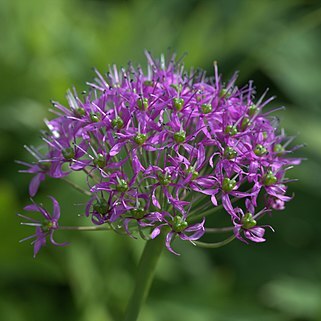Roots elongate, thick. Bulb solitary or clustered, cylindric; tunic yellowish brown, laciniate or fibrous to subreticulate. Leaves linear to oblong-lanceolate or lanceolate, shorter than to subequaling scape, (2--)5--20 mm wide, midvein distinct, base narrowed into a petiole or not. Scape lateral, (10--)20--50(--110) cm, 3-angled, sometimes narrowly 3-winged, covered with leaf sheaths only at base or for ca. 1/2 its length. Spathe 1-or 2-valved, deciduous. Umbel hemispheric, laxly or densely flowered. Pedicels subequal, 2--4 × as long as perianth, ebracteolate. Perianth stellately spreading, recurved after anthesis, pale red, red, or purple to blackish purple, rarely white; segments oblong-elliptic to narrowly so, 5--9 × 1.5--2 mm, apex retuse or obtuse. Filaments subulate, shorter than to subequaling perianth segments, connate at base and adnate to perianth segments. Ovary obovoid-globose, smooth; ovules 2 per locule. Style longer than ovary. Fl. and fr. Jul--Oct.
More
An onion family plant. It is a herb which produces a bulb. It grows to about 65 cm high. The bulbs are small and clustered. The roots are long and thick. The stem base is covered with the leaf sheath. The leaves are narrow and flat. They have a garlic like smell when squeezed. The flowers are purple. They occur in clusters at the top of the plant. Some varieties have been described.
Forest clearings and shrubberies, fully open to the monsoon rains; at elevations from 2,800-4,300 metres in Pakistan. Forest margins, scrub, meadows, stream banks; at elevations from 2,300-4,800 metres in southern China.
More
It is a temperate plant. In Nepal it grows at 2400-4500 m altitude. It grows in moist, rocky places. In China it grows in forest margins and stream banks between 2300-4800 m altitude in S China. In Sichuan and Yunnan.

